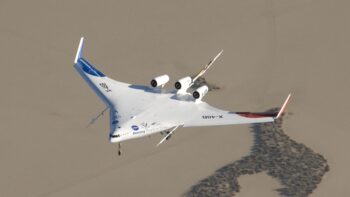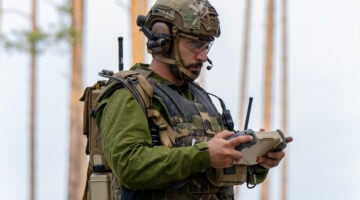
UPDATED 8/17/23 at 12:10 PM ET with comments from Lockheed and Boeing, following remarks from AFA event.
WASHINGTON — Air Force Secretary Frank Kendall announced today that startup firm JetZero has been chosen to build a demonstrator aircraft with a blended wing body (BWB) by 2027, which the US government hopes will prove out a revolutionary design to meet the needs of future military refueling and cargo missions, as well as commercial voyages.
“There’s a real potential in this technology to help increase fuel efficiency significantly, and that’s going to lead to improvements in not just the efficiency and capabilities of our force, but also in our impact on the climate,” Kendall said during an event hosted by the Air & Space Forces Association.
The sleek, flying wing-shaped BWB — whose name derives from the jet’s wings and fuselage blended together, leaving no clean break between the two — is a concept that’s existed for decades, and previous subscale demonstrators have been tested, like Boeing’s X-48 built in partnership with NASA. JetZero’s BWB will be a full-scale demonstrator, as the program’s solicitation specifically called out applications for tanking, cargo and even commercial tasks.

For the project, on the government’s side the Air Force is teamed with the Defense Innovation Unit and NASA. It’s unclear what other companies may have been in competition for the $235 million demonstrator award. Like Boeing, Lockheed Martin has previously explored innovations in new aircraft designs, such as its hybrid wing body jet for NASA. Following publication of this article, a Lockheed spokesperson confirmed the company did not participate in the BWB solicitation; Boeing declined to comment.
Tom O’Leary, JetZero cofounder and CEO, said during the event that the company’s demonstrator is a “public-private partnership,” and that private investment coupled with the Pentagon’s $235 million award will help “take the full-scale demonstration to fruition.” For his part, Kendall said that the government is “looking forward to continuing competition in this area,” calling the BWB demonstrator a “pathfinder project” and a “win-win” for commercial industry and the DoD.
Fielding viable BWB aircraft could mark a new chapter in aviation, where substantial aerodynamic improvements could leap ahead of previous incremental gains in propulsion, according to Tim Walton, an aviation expert at the Hudson Institute.
“In general, the great majority of efficiency improvements in the aviation sector have been driven by improvements in engine designs, propulsive efficiency improvements, and this is an opportunity to continue to drive down emissions and fuel expenditures through aerodynamic efficiency,” Walton told Breaking Defense in a June interview.
Interest in the BWB has grown recently in large part due to interest in reducing emissions and boosting fuel efficiency, with the Air Force listing a BWB prototype as a key part of its climate action plan [PDF]. According to JetZero, its BWB airframe design would halve fuel burn.
Until now, Walton said, myriad factors made BWB aircraft less feasible, such as figuring out how aircraft controls would work and the design’s limited ability to accommodate configuration changes. BWB aircraft are more highly integrated than their traditional tube-shaped counterparts, he explained, which in the past made it relatively more difficult to make modifications.
“So the implication of that is for commercial aircraft, design and manufacturing, it would be more expensive to have to develop new iterations of the design if you wanted to have a family of different blended wing body aircraft,” he said.
The BWB demonstrator could be a contender for future tanker and cargo recapitalization as the Air Force weighs strategies for fielding a next-gen tanker and airlifter. Already, defense giant Northrop Grumman has lined up behind JetZero as a partner to serve as an integrator of military mission systems, according to a report in Aviation Week.
Tom Jones, president of Northrop’s aeronautics systems sector, also spoke today at the AFA event and said that company subsidiary Scaled Composites “is going to be working primarily in helping to develop and build the prototype.” Northrop, he said, can also serve as a “weapon systems integrator.”
With all participants in the event pointing to a potential conflict in the Indo-Pacific, Jones said, “We really believe that the value the JetZero blended wing body brings both in cargo as well as in tanking, I think really opens up a whole new realm of dimensions in terms of the art of the possible solving this problem.”
Early analysis of a future tanker, known as the Next Generation Air-refueling System (NGAS), is underway, and Walton said three different types of aircraft will likely be closely considered for the role: commercial off-the-shelf tankers suited for austere operations, stealthy tankers that could perform refueling runs in contested environments, and BWB designs. The Air Force could buy one or more tanker designs for its NGAS family.
With a lower radar cross section compared to traditional refueling aircraft, the BWB could also offer increased stealth features, Walton observed, short of more expensive low-observable coating used on aircraft like the B-2 and F-35. Proceeding with the demonstrator, Walton said, is a key opportunity to validate its efficacy and begin to buy down risk for producing a future tanker version.
Today Ravi Chaudhary, assistant secretary of the Air Force for energy, installations and the environment, pointed to the service’s NGAS and NGAL (Next Generation Airlift) efforts as potential “entry points” for BWB technology, though he said officials are currently focused on “the knowledge of this capability.”
Air Force Maj. Gen. Albert Miller, Air Mobility Command’s director of strategy, plans, requirements and programs, similarly advised that with the service only in the pre-analysis of alternatives stage for NGAS, it would be “very premature to say that this is the NGAS solution absolutely.
“I would caution anybody from drawing linkages directly to NGAS or NGAL,” he added. “It’s a prototype that we will learn from.”

